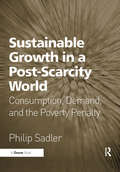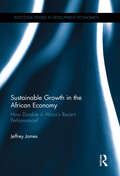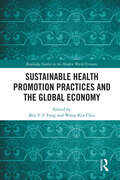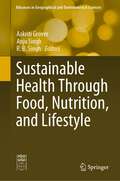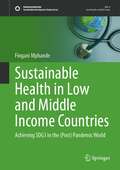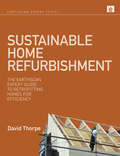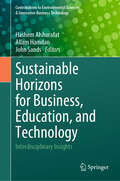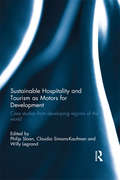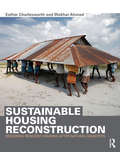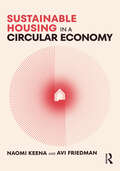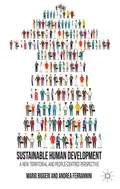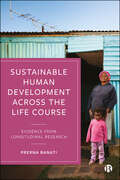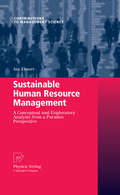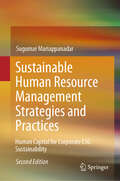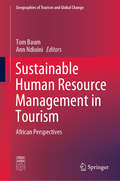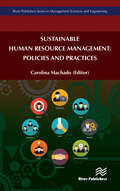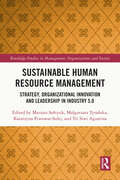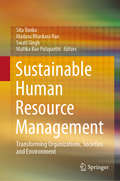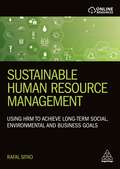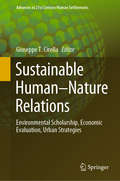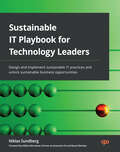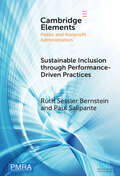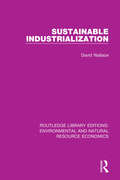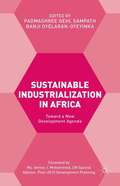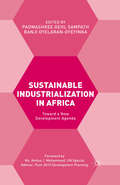- Table View
- List View
Sustainable Growth in a Post-Scarcity World: Consumption, Demand, and the Poverty Penalty
by Philip SadlerOver 20 years ago Philip Sadler, then head of a leading British business school, wrote Managerial Leadership in the Post-Industrial Society. In it he predicted that business would experience the most radical transformation since the Industrial Revolution of the 19th century. This transformation has now taken place. In his latest book, Sustainable Growth in a Post-Scarcity World, Sadler charts developments once envisaged by Keynes, Chase, Galbraith and Packard, and more recent radical thinkers such as Chris Anderson. Sadler describes how many goods and services have moved from relative scarcity to relative abundance, and asks how this trend can be reconciled with the global issues of population growth and climate change. He assesses the impact of new technologies, new energy sources, new materials and the development of artificial intelligence, on business, government and economics, and discusses the challenges ahead - the creation of new business models, the need to meet people's legitimate expectations of improved living conditions while avoiding environmental catastrophe, and the need to adapt ideas developed in scarcity to conditions of abundance. Why is it that in countries foremost in creating post-scarcity conditions, millions are still in poverty, and billions, worldwide, still lack basic necessities of life? Philip Sadler agrees with those who say the relief of global poverty cannot rely on aid and corporate philanthropy. He explores the idea of re-engineering products and delivering them into bottom-of-the-pyramid (BOP) markets, and concludes that the more global companies take this route, as some are already doing, the more profitable they will find it, and this will in turn help the poorest people who currently pay more for goods and services - the 'poverty penalty' - than the rich.
Sustainable Growth in the African Economy: How Durable is Africa’s Recent Performance? (Routledge Studies in Development Economics)
by Jeffrey JamesThe current growth path in sub-Saharan Africa is not following the Lewis model where labour moves from low-productivity agriculture to higher productivity manufacturing. Instead, it is moving directly to inappropriate (import and labour-saving) methods. This book seeks to show how this distorted growth process leaves out the major resource of these countries – labour – and ends up creating unstable employment and underemployment, leading to inequality and poverty. In this way it demonstrates how the entire growth process may be rendered unstable and unsustainable. Sustainable Growth in the African Economy considers whether the relatively rapid growth of recent years can be maintained or improved upon, with a focus on the process of industrialisation. Basing itself on a well-known dual-economy model, the proposed book focuses on several major problems of industrialisation, which has long been seen as the means of structural change in an economy which begins from a low income level. The book considers how the future trajectory of sub-Saharan Africa compares to recent success stories on other continents, and explains how factors such as rapid population growth and capital and import-intensive technology in manufacturing could foreshadow future social and political problems. This book will be essential reading to students and policymakers who are concerned with the existing pattern of African growth.
Sustainable Health Promotion Practices and the Global Economy (Routledge Studies in the Modern World Economy)
by Ben Y. F. Fong Wang-Kin ChiuThis book reviews the strategies for the development of sustainable health promotion practices, including the Sustainable Development Goals (SDGs), with case examples from the COVID-19 pandemic.Beginning with a historical survey of the global agenda of health promotion over the past decades, the book analyses the evolving standards, goals and strategies of health promotion as well as the challenges encountered in implementing health promotion practices during the COVID-19 pandemic. Both social and environmental determinants of population health are examined here. Contributors have assessed socio-economic inequalities present in health promotion practices and highlighted the need for balance between economic development and financial sustainability in health services and educational programming. A framework for improved lifelong population health for all is also suggested.This review of social, economic, environmental, and ecological contexts in health promotion will be of interest to policymakers, academics, and practitioners. In particular, scholars of health policy and health promotion, as well as public administration and development studies, will find this a useful volume.
Sustainable Health Through Food, Nutrition, and Lifestyle (Advances in Geographical and Environmental Sciences)
by R. B. Singh Aakriti Grover Anju SinghThis book uncovers the multiple layers of challenges posed to achieve sustainable human health and improves the understanding of interactive areas set by the UN Sustainable Development Goals (1) no poverty, (2) zero hunger, (3) good health and wellbeing, (6) clean water and sanitation, and (11) sustainable cities and communities. The book focuses on conceptual understanding, food, nutrition, lifestyle, and their integration to reinforce the ideas of holistic health principles.' The most important drivers of sustainable health are food, nutrition, and lifestyle. Healthy food is a basic need of human beings. In under-developed regions, people are underweight and facing malnutrition, with a prevalence of deficiency diseases due to low intake of micro-nutrients such as vitamin A, iodine, and protein among others. A good diet as well as lifestyle has a tremendous bearing on a person’s health, emotional stability, and enthusiasm for life. The global coronavirus pandemic has brought unimaginable devastation and hardship in all corners of the globe, questioning the existing healthcare services, health policies, and health planning across the developed and developing countries. It has also exposed the lacunae in understanding health, the base of human happiness. The global community needs to gravely ponder the health issues we are facing and explore sustainable solutions for health recovery and the wellbeing of humanity.
Sustainable Health in Low and Middle Income Countries: Achieving SDG3 in the (Post) Pandemic World (Sustainable Development Goals Series)
by Fingani MphandeThis book highlights lessons from the COVID-19 pandemic and explains how these can be used to build sustainable health systems, especially in Low- and Middle-Income Countries (LMIC). It investigates the impact of outbreak response and management on health sustainability in LMIC from the perspective of SDG3: “Ensuring healthy lives and wellbeing for all at all ages”. Despite strides being made in some areas for SDG target 3.3 to fight communicable diseases, the COVID-19 pandemic has caused interruptions that will considerably affect vaccination coverage as well as the progress that was made, for example: in reducing malaria cases. Vulnerable populations who were already struggling to access their healthcare needs before the pandemic may face even greater challenges at present and in the years to come, post-pandemic. This book considers the progress on attaining the SDG3 targets, specifically: to improve early warning systems for management of national and global health risks, and the effect of pandemics - including but not limited to the COVID-19 pandemic - and emerging disease outbreaks. It explores the weaknesses and strengths in LMIC and how to strengthen capacities in these countries. The author also investigates and proposes approaches that can, or should, be implemented to ensure sustainable health systems in developing countries, including early warning systems, risk reduction, and the management of global and national health risks. This book is of great interest to public health professionals, infectious diseases experts, and epidemiologists, as well as students and researchers of public health systems and healthcare infrastructure in developing countries.
Sustainable Home Refurbishment: The Earthscan Expert Guide to Retrofitting Homes for Efficiency (Earthscan Expert)
by David ThorpeA retro-fit offers many benefits: cutting electricity and heating bills, increasing the resale value of homes, slashing carbon emissions and creating a healthier place to live. This book is the guide to making it happen. It looks at: draught-proofing, insulation and damp ventilation, heating and cooling electrical efficiency and renewable energy water use and re-use materials' life cycles and incorporating nature protection from climate change impacts - modelling energy flows and embodied energy how we can meet the need to cut carbon emissions from dwellings by eighty percent by 2050. Projects can apply to apartment blocks, recent builds and older, solid-walled properties. Enlivened with helpful diagrams and photographs, plus plenty of pointers for further information, it provides a comprehensive resource handbook for any building professional and contractor, students – or any homeowner serious about efficiency (cash and carbon) savings.
Sustainable Horizons for Business, Education, and Technology: Interdisciplinary Insights (Contributions to Environmental Sciences & Innovative Business Technology)
by Allam Hamdan Hashem Alshurafat John SandsThis book offers a detailed analysis of the intersection of sustainability, innovation, and global progress, and it comprehensively explores sustainable practices and their impact on business, education, and technology. The book shows how businesses can incorporate sustainability into their core operations, including environment-friendly supply chains, renewable energy adoption, circular economy models, ethical decision-making, and sustainable growth strategies. Successful sustainable businesses and the benefits of their socially responsible practices are highlighted. In addition, the book explores how education can shape a sustainable future. It is necessary to integrate the ideas of sustainability into the curricula of early childhood education to higher learning institutions to educate and empower the next generation of changemakers. The role of technology in advancing sustainability efforts is also investigated, including artificial intelligence, blockchain, clean energy solutions, green architecture, and smart cities. Other topics explored in the book include global sustainability efforts such as international collaborations, public-private partnerships, and multilateral initiatives; the role of governments, NGOs, and international organizations in promoting sustainable development; ethical considerations and social impacts of sustainable practices, for example, social justice, inclusivity, and environmental stewardship; connections between sustainable development and improved quality of life; and groundbreaking ideas and innovations for industries to tackle sustainability issues. The book offers a comprehensive and forward-looking perspective on sustainability. By combining different viewpoints, the book empowers readers with the knowledge and inspiration to contribute meaningfully to a more sustainable, inclusive, and resilient world.
Sustainable Hospitality and Tourism as Motors for Development: Case Studies from Developing Regions of the World
by Philip Sloan Willy Legrand Claudia Simons-KaufmanIt is now widely agreed that the climate is changing, global resources are diminishing and biodiversity is suffering. Developing countries – many of them considered by the World Tourism Organization to be 'Top Emerging Tourism Destinations' (UNWTO, 2009) – are already suffering the full frontal effect of environmental degradation. The challenge for developing countries is a triple-edged sword, how can economic prosperity be achieved without the perpetual depletion of nature’s reserves, the destruction of rural habitat and the dislocation of traditional societies? Many emerging nations are looking increasingly to the tourism industry as the motor for economic development, with hospitality businesses at the forefront. This book uses twenty-five case studies to demonstrate how it is possible to create income and stimulate regional socio-economic development by using sustainable hospitality and tourism attractions. These case studies focus on issues such as the protection of indigenous cultures as a source of touristic curiosity; the preservation of the environment and the protection of endangered species – such as the plight of turtles in Sri Lanka or butterflies in Costa Rica to encourage tourism. Some cases cover government supported projects, for example, the green parks venture and regional tourism development in the Philippines, an archaeological park initiative in Honduras and the diversity of nature tourism in St. Vincent. Sustainable Hospitality and Tourism as Motors for Development is designed to give students, academics and practitioners a guide for best practices of sustainable hospitality operations in developing countries. Based on case studies, it provides a road map of how to achieve the goals of sustainability giving benchmark examples. The book not only taps into a contemporary business subject, but aims to provide readers with a better understanding of how sustainable theories can be put into practice in hospitality and tourism industries in developing countries.
Sustainable Housing Reconstruction: Designing resilient housing after natural disasters
by Esther Charlesworth Iftekhar AhmedThrough 12 case studies from Australia, Bangladesh, Haiti, Sri Lanka, Vietnam and the USA, this book focuses on the housing reconstruction process after an earthquake, tsunami, cyclone, flood or fire. Design of post-disaster housing is not simply replacing the destroyed house but, as these case studies highlight, a means to not only build a safer house but also a more resilient community; not to simply return to the same condition as before the disaster, but an opportunity for building back better. The book explores two main themes: Housing reconstruction is most successful when involving the users in the design and construction process Housing reconstruction is most effective when it is integrated with community infrastructure, services and the means to create real livelihoods. The case studies included in this book highlight work completed by different agencies and built environment professionals in diverse disaster-affected contexts. With a global acceleration of natural disasters, often linked to accelerating climate change, there is a critical demand for robust housing solutions for vulnerable communities. This book provides professionals, policy makers and community stakeholders working in the international development and disaster risk management sectors, with an evidence-based exploration of how to add real value through the design process in housing reconstruction. Herein then, the knowledge we need to build, an approach to improve our processes, a window to understanding the complex domain of post-disaster housing reconstruction.
Sustainable Housing in a Circular Economy
by Avi Friedman Naomi KeenaThis book relates circular economy principles to housing design and construction and highlights how those principles can result in both monetary savings, positive environmental impact, and socio-ecological change.Chapters focus on three key circular economy principles and apply them to architectural construction and design, namely rethinking of the end-of-use phase of a building and the potential of design-for-disassembly; the role of digitization and data standardization in fostering evidence-based circular economy design decision-making; and presenting space as a resource to conserve, via exploration of the sharing economy and flexibility principles. Beyond waste management and material cycles, this book provides a holistic understanding of the opportunities across the building life cycle that can allow for sustainable and affordable circular housing. With case studies from 13 different countries, including but not limited to the Hammarby Sjöstad district in Sweden, the Circle House in Denmark, Benny Farm in Canada, VMD Prefabricated House in Mexico, and the Deep Performance Dwelling in China, authors pair theoretical frameworks with real-world examples.This will be a useful resource for upper-level students and academics of architecture, construction, and planning, especially those studying and researching housing design, building technology, green project management, and environmental design.
Sustainable Human Development
by Mario Biggeri Andrea FerranniniIntegrating Amartya Sen's approach with the literature on place-based territorial development processes, this book recognises the interplay between the evolution of local development systems and the expansion of individual and collective capabilities.
Sustainable Human Development Across the Life Course: Evidence from Longitudinal Research
by Prerna BanatiIt is critical that the wellbeing of society is systematically tracked by indicators that not only give an accurate picture of human life today but also provide a window into the future for all of us. This book presents impactful findings from international longitudinal studies that respond to the United Nations’ Agenda 2030 commitment to “leave no-one behind”. Contributors explore a wide range and complexity of pressing global issues, with emphasis given to excluded and vulnerable populations and gender inequality. Importantly, it sets out actionable strategies for policymakers and practitioners to help strengthen the global Sustainable Development Goals framework, accelerate their implementation and improve the construction of effective public policy.
Sustainable Human Resource Management
by Ina EhnertPredictions are that sustainability becomes the next big topic for Human Resource Management after internationalization and globalization. This book gives new answers to these questions: - How can HRM contribute to attracting, developing and retaining highly qualified human resources over time? - How can a paradox perspective contribute to understanding and coping with paradoxical tensions? - How can sustainability be used as a 'deliberate strategy' for HRM? The conceptual part of the book looks at the notion of sustainability, opens it up for Strategic HRM and identifies blind spots in Strategic HRM theory. Paradox theory is introduced as an analytical framework for Sustainable HRM. Initial suggestions are made for sustainability strategies and for coping with paradoxes and tensions. The exploratory part examines how 50 European Multinationals communicate their understanding of sustainability and HRM and which HR issues and practices they are linking to the topic.
Sustainable Human Resource Management Strategies and Practices: Human Capital for Corporate ESG Sustainability
by Sugumar MariappanadarThe 2nd edition of Sustainable Human Resource Management: Strategies, Practices and Challenges delves into the evolving landscape of sustainable HRM. Replacing three chapters, it introduces fresh topics like 'Corporate Sustainability Business Strategy Context for Sustainable HRM,' 'High-Performance Sustainable Work Practices for Corporate Sustainability,' and 'Sustainable HRM for Employee Health and Well-being.' All chapters are updated with the latest developments since the 1st edition in 2019. This edition's significance lies in its role in academic curricula worldwide, meeting the demand for sustainable HRM courses and aiding research expansion. As businesses align with sustainability goals, this book becomes a guide for HR and line managers, fostering integrated economic, social, and environmental outcomes.
Sustainable Human Resource Management in Tourism: African Perspectives (Geographies of Tourism and Global Change)
by Tom Baum Ann NdiuiniThis book addresses the application of sustainable HRM principles within tourism in the specific context of Africa, a neglected area of study. It draws on diverse aspects of HRM, from the micro- (individual) through the meso-level (organisational) to the macro-level (policy, governmental). It also reflects the diverse challenges facing a critical area within emerging African tourism, that of its workforce. The book is substantially research-based and provides a state-of-the-art picture of emergent studies in this area, drawing on case examples from a wide-range of African contexts. As such, it provides a comprehensive resource and starts discussion in an emergent research area.
Sustainable Human Resource Management: Policies and Practices
by Carolina MachadoSustainable Human Resource Management: Policies and Practices covers issues related to sustainable human resource management in a context where organizations are continually facing significant challenges related to the continuous change in the market, as well as in the environment. Organized in different chapters, the book includes contributions from renowned international researchers in the field of sustainability and organizations, and human resource management.Providing recent research advances on Sustainable Human Resource Management, it can be used in an undergraduate management and engineering course (for example, management, human resource management, industrial, manufacturing, economics, etc.), or as a subject on human resource management and industrial engineering at the postgraduate level. Also, this book can serve as a useful reference for academics, researchers, managers and manufacture and industrial engineers, as well as all professionals who work in fields related to management and human resource management, sustainability and industrial engineering.
Sustainable Human Resource Management: Strategy, Organizational Innovation and Leadership in Industry 5.0 (Routledge Studies in Management, Organizations and Society)
by Mariusz Sołtysik Katarzyna Piwowar-Sulej Małgorzata Tyrańska Tri Siwi AgustinaGlobal trends favor balanced development, integrating socio-economic and environmental aspects. Sustainable development, emphasized by international organizations and the UN's Sustainable Development Goals, has evolved into Industry 5.0. Unlike Industry 4.0, Industry 5.0 prioritizes social justice and sustainable development, focusing on human-centricity, ecological balance, and resilience. It advocates for circular processes, reduced waste, and lowered environmental impact. The transition to a green economy requires bottom-up efforts from eco-entrepreneurs. In the era of knowledge-based economies, enterprises emphasize sustainable development, including the transition to Sustainable Human Resource Management (SHRM). SHRM combines sustainability with a soft approach to human resources, fostering trust, teamwork, and employee commitment. However, literature on SHRM lacks a universally accepted definition. This monograph aims to bridge gaps through theoretical and empirical examinations of connections between sustainable HR practices and Industry 5.0, identifying competencies needed for effective implementation within this framework. The study contributes to the understanding of the evolving relationship between Industry 5.0 and sustainable HR practices, setting the stage for further research.
Sustainable Human Resource Management: Transforming Organizations, Societies and Environment
by Sita Vanka Madasu Bhaskara Rao Swati Singh Mallika Rao PulaparthiThis book provides a multi-stakeholder perspective on sustainable HRM for the policymakers, managers and academics, addressing issues, approaches, research studies/frameworks and emerging patterns relating to the subject. It discusses various aspects of sustainability, such as making HR more responsible for ensuring sustainability focusing on the triple bottom line, characteristics of sustainable HRM, psychological contracts, emotional intelligence, and psychological capital. The book also explores organizational citizenship behavior, employment relations, employee engagement, sustainable leadership, disruptive HR practices, sustaining employee motivation, educational sustainability, sustainable career management, sustainable environment, employer and employee branding, sustainable organizations, organization culture, training for sustainability, sustainable employee performance, business sustainability and sustainable employability. It provides an update on the concept, processes, issues and emerging paradigms from multidimensional and cross-country perspectives to showcase sustainable HR practices, and appeals to the academics, practitioners and policymakers in the area of HRM.
Sustainable Human Resource Management: Using HRM to achieve long-term social, environmental and business goals
by Dr Rafal SitkoSustainable human resource management (HRM) processes and practices are not a nice-to-have, they're a need-to-have to benefit employees, organizations, societies and the environment. Sustainability has been highlighted by the Chartered Institute of Personnel and Development (CIPD) as one of the key trends influencing the HR profession so Sustainable Human Resource Management is crucial reading for undergraduate and postgraduate HR students. It explains what sustainable HRM is, what the benefits of sustainable HRM are as well as the dangers of unsustainable HRM. It is full of examples throughout to show how sustainable HRM works in practice including how it can be used to improve candidate attraction, retention and employee engagement as well as how it can improve productivity, employer branding, company culture and drive both efficiency and business performance. There is also coverage of how sustainable HRM can be introduced and measured as well as specific guidance on sustainable HRM in different parts of the world, green HRM, responsible business, ethics and sustainable HRM as a business strategy. Sustainable Human Resource Management is written specifically for third year undergraduate and postgraduate students with pedagogical features in each chapter including learning objectives, key concept definitions, skill check boxes, workshop discussion articles, chapter summaries, study questions and key readings. Online resources include a sample course handbook and PowerPoint slides.
Sustainable Human–Nature Relations: Environmental Scholarship, Economic Evaluation, Urban Strategies (Advances in 21st Century Human Settlements)
by Giuseppe T. CirellaThis book addresses sustainability thinking and the bigger picture, by taking into consideration how and from where contemporary schools of thought emerged approximately a quarter-century ago. Evidence from the literature illustrates a number of key concepts and techniques that have been tested and continue to be tested, within various multi-disciplinary fields, on societal functionality. Research into sustainable societies needs to be sound, ethical, and creative. A cross-sectoral, interdisciplinary examination of challenges and strategies is used to interlink sustainability thinking and human-nature relations. With an ever-growing number of people now concentrated within urban areas, providing not only environmental quality and livable space, but also security and resilient urban systems, is becoming increasingly important. This urbanization trend has overlapped with environmental degradation, consumption of natural resources, habitat loss, and overall ecosystem change. Consequently, the goal is for cleaner, safer societies – with higher standards of living – to excel in support of current and future generational communities. The book tackles these challenges by integrating environmental scholarship, economic evaluation, and urban strategies under one umbrella of thought. The relational paradigms presented include examples that correlate developed and developing countries, socioeconomics and community development, and governance of knowledge and education. As such, the book argues, furthering of knowhow should be accessible and shared in order to achieve maximum innovation and benefit. Sustainability thinking, after all, is a metric for intrinsic human-nature relations in terms of past performance, present development, and future goals. This book discusses this metric and offers novel approaches to growing societies and what we can do next.
Sustainable IT Playbook for Technology Leaders: Design and implement sustainable IT practices and unlock sustainable business opportunities
by Niklas Sundberg Helene BarnekowAt a critical point in human history, this book presents proven ways to gain the skills needed to develop sustainable IT practices and set yourself apart as a progressive technology leaderKey FeaturesExecute a sustainable IT strategy with proven methods and real-world use casesProgress as a sustainable IT advocate and set yourself apart from other senior IT leadersIncrease your chances of receiving executive buy-in on your sustainable IT strategyBook DescriptionWe are at a critical point in human history. Humanity is under threat, but all is not lost. We can take action! But how?Sustainable IT Playbook for Technology Leaders will show you how. It will walk you through the construction and implementation of a sustainable IT strategy and enable you to do your bit for the future of mankind.The book is split into three parts. Part I details the “why” and the clear and present danger that humanity faces today: the climate crisis. How did we get here, what are the immediate threats, what are the planetary boundaries that we need to peel back to safe levels, and what impact does IT have on society at large? Part II will focus on the "what.” It examines the nitty-gritty details of what we can do to unlock significant returns on sustainable investments toward a more sustainable future. Part III, the final part of the book, focuses on the “how.” How do you turn your ideas into action? What do you need to do to establish your baseline and your direction of travel towards your objective? This part provides tangible case studies and explains how you can start your journey today to begin delivering global and impactful objectives.By the end of this book, you'll be able to plan, implement, and communicate a sustainable IT strategy and set yourself apart as a progressive technology leader.What you will learnDiscover why IT is a major contributor to carbon emissionsExplore the principles and key methods of sustainable IT practicesBuild a robust, sustainable IT strategy based on proven methodsOptimize and rationalize your code to consume fewer resourcesUnderstand your energy consumption patternsApply a circular approach to the IT hardware life cycleEstablish your sustainable IT baselineInspire and engage employees, customers, and stakeholdersWho this book is forThis book is for executive IT leaders such as CIOs, CDOs, and CTOs dedicated to influencing, inspiring, and engaging businesses, organizations, and individuals to reduce their carbon footprint through sustainable IT practices.
Sustainable Inclusion through Performance-Driven Practices: An Evidence-Based, Dynamic Systems Framework (Elements in Public and Nonprofit Administration)
by Ruth Sessler Bernstein Paul SalipanteHow can organizations better achieve inclusion, equity, and superior performance from diversity? Decades of stalled progress require a wider range of policies. Applying a system thinking approach to a transdisciplinary synthesis of research findings, the authors' comprehensive framework guides inquiry and practice by identifying problematic dynamics. Comparative case studies reveal, in contrast, favorable dynamics of intergroup contact that result from an evolved elaboration of practices for inclusive interactions, socialization, and accountability. Over time, when promoted for mission attainment, applied to all members, and customized to the workgroup, the practices generate inclusion, equity, and superior performance.
Sustainable Industrialization (Routledge Library Editions: Environmental and Natural Resource Economics)
by David WallaceThis report, first published in 1996, argues that radical changes in industrial organization and its relationship to society tend to arise in rapidly industrializing countries, and that new principles of sustainable production are more likely to bear fruit in developing than in developed countries. The rising tide of investment by multinational firms – who bring managerial, organizational and technological expertise – is a major resource for achieving this. Developing countries could steer such investment towards environmental goals through coherent and comprehensive policies for sustainable development.
Sustainable Industrialization in Africa: Towards a New Development Agenda
by Banji Oyelaran-Oyeyinka Padmashree Gehl SampathSustainable Industrialization in Africa.
Sustainable Industrialization in Africa: Towards a New Development Agenda
by Banji Oyelaran-Oyeyinka Padmashree Gehl SampathSustainable Industrialization in Africa explores the issues that confront development policy in the context of the MDGs and the post-2015 development agenda from an African perspective. The book argues that development is an ultimate outcome of sustainable, equitable industrialization, and that any development agenda for the future has to ensure that industrialization is fostered in a way that makes economies independent and responsive to the needs of all citizens. Future challenges for sustainable industrialization in Africa, based upon the differences in its current industrialization trajectories, are discussed to ensure that industrial growth results in positive economic and social outcomes in the context of the post-2015 development agenda.
